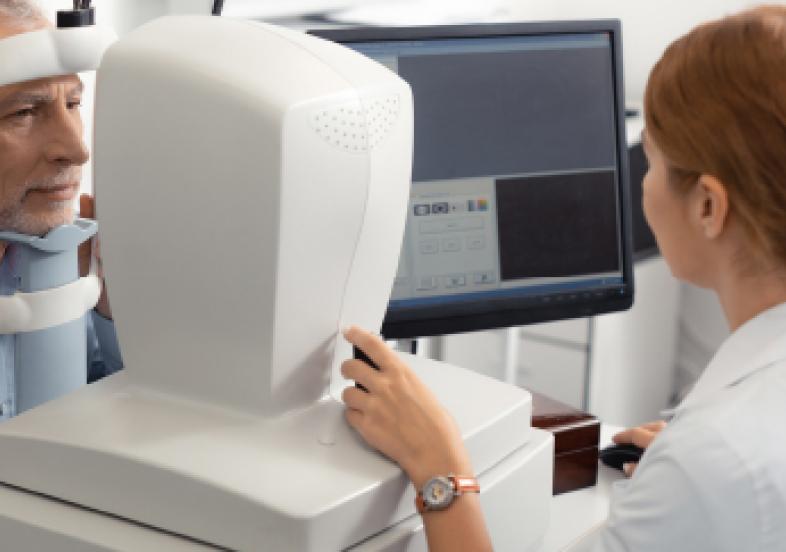
This is the third in the Canadian Association of Optometrists (CAO) vision health education monthly series launched in May 2022. The series provides regular insights into important services that optometrists provide as part of comprehensive and follow-up (recall) eye examinations that are not always fully reimbursed by group vision care plans today.
The important take away message from this series is that functional and structural changes in the eye can be detected through specialized testing. Visual Field tests can detect functional changes before an individual notices any changes to their vision (#2 in this series). Structural changes can be detected through an Optical Coherence Tomography (OCT) scan well before symptoms or functional changes start to happen. The Visual Field and OCT work together for diagnosing and managing serious conditions.
These tests and others are critical in mitigating vision loss and avoiding higher medium- and long-term costs to plans in prescription drugs, assistive devices and in some cases long-term disability. While provincial plans typically provide reasonable coverage once a diagnosis is made, there is a gap in public coverage for tests that can lead to early diagnosis and intervention. With the information contained in this series, plan sponsors, advisors and insurers can consider how to amend their plans to fill the gaps that exist between private and public coverage.
An OCT scan, like a Visual Field test, is part of a comprehensive examination and some recall examinations when ongoing monitoring or treatment is required. Unlike the Visual Field test, an OCT scan uses light waves to take cross-section images of your retina much like a CT scan. The retina is the area at the back of the eye that plays an important function of detecting light and sending this information to the brain, which is what allows us to see.
Why is an OCT scan so important?
Rather than just a view into the eye, the OCT allows the optometrist to detect and diagnose eye conditions by looking directly into the layers at the back of the eye at a high resolution to map and measure their thickness. When there are signs of disease these layers will change, and their integrity will degenerate. This can visualize any fluid, blood, waste, abnormal growth, and other irregularities in the retina. It is the only test where optometrists can see the layers in the eye that change with disease.
Normal OCT image
The OCT scan is an important diagnostic tool. An optometrist may see evidence of glaucoma, age-related macular degeneration (AMD), diabetic retinopathy or other damage to the retina. They may also see evidence of ocular manifestations of systemic diseases, in which case they will refer their patient to a physician for further assessment and diagnosis.
Guidelines for when an is OCT should be conducted:
An OCT is conducted initially to screen for eye disease and create a baseline against which future changes in the retina can be measured.
If initial OCT results are outside normal range, then the optometrist may suggest a recall exam over a period of a year or two to monitor for any changes in the retina.
Even those in their working years should be considered for an OCT scan
Since eye disease is common in those under 60, coverage for OCT scans under group plans is an important element of vision care benefits:
- Approximately 76,000 Canadians under 60 have vision loss due to glaucoma,1 and only half of the approximately 730,000 with glaucoma are diagnosed.2,3
- Approximately 14% of Canadians with vision loss due to age-related macular degeneration (AMD) are under the age of 60.1
Approximately 71,000 Canadians under 60 have vision loss due to Diabetic Retinopathy (DR)1 and rates of diabetes are climbing. Today 1 in 3 Canadians have diabetes or prediabetes and the numbers are forecast to increase.4 An estimated 50% of non-First Nations Canadians of young age, and an estimated 80% of First Nations people of young age will develop diabetes in their lifetime.
The value of OCT scans in protecting the vision of plan members is supported by clinical evidence, however, OCT scans are not covered by the majority of provincial plans until vision loss has already happened.
The Canadian Association of Optometrists (CAO) recommends that plan sponsors, insurers, and group benefit advisors review group vision care plans to ensure coverage for OCT and other diagnostic tools are eligible for reimbursement, particularly during the initial testing and monitoring phase. Doing so will ensure that plan members and their dependents have access to the services of an optometrist to mitigate the impact of serious eye diseases like glaucoma and other health conditions that can affect vision.
CAO represents more than 80% of optometrists across Canada who are committed to the vision health of all Canadians. If you require any assistance, have any questions, or would like to consult with the CAO on how to examine your vision care plan for gaps in care and help modernize it, please do not hesitate to reach out to us at info@opto.ca.
References
- Deloitte. (2021). The cost of vision loss and blindness in Canada. Canadian Council for the Blind. Available from: https://www.fightingblindness.ca/wp-content/uploads/2021/12/Deloitte-Cost-of-vision-loss-and-blindness-in-Canada-report-May-2021.pdf
- Perruccio, A. V., Badley, E. M., & Trope, G. E. (2007). Self-reported glaucoma in Canada: findings from population-based surveys, 1994–2003. Canadian Journal of Ophthalmology, 42(2), 219-226. Available from: https://pubmed.ncbi.nlm.nih.gov/17392843/
- CAO, COS, CGS, CFPC. (2015, January 8). Primary Care Physician Guide – Glaucoma. [Infographic]. Canadian Association of Optometrists. Available from: https://opto.ca/document/primary-care-physician-guide-glaucoma
- 2019 Diabetes Cost Model, Diabetes Canada.
- Turin, T. C., Saad, N., Jun, M., Tonelli, M., Ma, Z., Barnabe, C. C. M., ... & Hemmelgarn, B. (2016). Lifetime risk of diabetes among First Nations and non–First Nations people. Canadian Medical Association Journal, 188(16), 1147-1153. Available from: https://www.cmaj.ca/content/188/16/1147